Antifibrosis agents aid primary trabeculectomy
5-FU and mitomycin can aid management of a large group of patients.
One major advance in the surgical management of glaucoma involves the use of antimetabolites to prevent postoperative scarring. This advance helps because lower target pressures are needed to stop disease progression. So modulating healing after surgery is increasingly important.
The healing response is the major factor in the long-term outcome of filtering surgery, but also the main reason for failure. Modulating the healing response lets the surgeon target the lowest safe level of intraocular pressure (IOP) in all patients undergoing filtration surgery.
We have many good antimetabolite agents that are inexpensive and currently available. The appropriate choice of the agent and the regimen is important.
We need to achieve maximal lowering of IOP to reduce long-term progression. We now have the tools and the agents to do that. The new goal has become an IOP in the low teens with a low rate of progression.
Limit healing
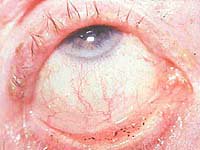 ---Adrenaline treated conjunctiva, "hidden" risk factor for surgical failure. (Figure 1)
---Adrenaline treated conjunctiva, "hidden" risk factor for surgical failure. (Figure 1)
Studies from around the world show that the success rate of primary surgery falls with time. A recent multinational analysis of patients studied at 3 months postop found 50% of patients were back on medical therapy. Therefore, at present, trabeculectomy is not absolutely ideal in terms of its success rate, so achieving the best postoperative outcome may depend upon antimetabolites.
In primary surgery, the key issue is to look for hidden risk factors. Patients on beta blockers and miotics have a 72% chance of success. Patients on sympathomimetics have a success rate of only 45%, which is worse than patients who have already failed previous surgery (Figure 1). If these success rates applied to all patients in the United Kingdom, that would mean 10,000 patients failing surgery every year if they were not treated appropriately.
Other risk factors include if a patient is of Afro-Caribbean origin. However, this race is not entirely homogenous, and another study conducted showed a high success rate in East Africans who have not had any metabolites.
There also are relative contraindications, such as the reaction of the fellow eye or the existence of lid problems and bleb exposure. High myopia is a relative contraindication, as is advanced age, corneal epitheliopathy, thin tissues, a previous history of complications and a drainage area not completely covered by the upper eyelid.
A red eye, for whatever the reason, indicates a poor prognosis and outcome, so it sends a warning sign after filtration surgery.
5-FU injections
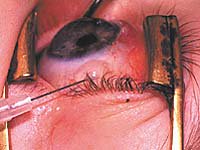 ---Subconjunctival 5-FU given adjacent but not into the bleb. (Figure 2)
---Subconjunctival 5-FU given adjacent but not into the bleb. (Figure 2)
5-FU provides a useful adjunct. The drug was pioneered in the 1980s. The original regimen called for 5 mg in 0.5-mL injections twice daily for 1 week, then once daily for another week. It is rarely given at this intensity anymore, with a more typical regimen of less than 10 injections given over several weeks.
However, injections can leak into the tear film and create problems with the epithelium. 5-FU injections are now an adjunct to the use of intraoperative antimetabolites, which are much more convenient.
The injection technique also is important. Most injections are about 5 mg in 0.1 mL straight from the bottle. The injection should be given adjacent to the bleb (Figure 2). Intrableb injections should be avoided, especially in soft eyes. 5-FU has a pH of 9, and it could damage the eye if given intraocularly.
I use the smallest needle possible, a 29-gauge needle on a disposable insulin syringe, to minimize reflux into the tear film. A longer subconjunctival track can reduce leakage and epitheliopathy. In cases where no leakage is vital (for example, post-graft), viscoelastics can be used to prevent leakage into the tear film.
Injections allow the surgeon to titrate treatment based on postoperative outcomes. They can be delivered for a late healing response several months after surgery if intraoperative antimetabolites already have been used.
However, injections are inconvenient and uncomfortable. They also create injection risks from subconjunctival hemorrhaging, epitheliopathy, hypotony, cystic blebs with leaks, blebitis and endophthalmitis.
Intraoperative 5-FU
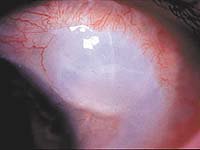 ---Bleb from mitomycin C 0.4 mg/mL treated area. Limbus-based flap, small scleral flap and relatively small area of treatment leading to focal cystic thin area. (Figure 3)
---Bleb from mitomycin C 0.4 mg/mL treated area. Limbus-based flap, small scleral flap and relatively small area of treatment leading to focal cystic thin area. (Figure 3)
Intraoperative 5-FU causes long-term but reversible fibroblast growth arrest. A concentration of 50 mg/mL used straight from the bottle is probably best used for between 3 and 5 minutes. There is little leeway for variation.
Intraoperative 5-FU is convenient and inexpensive. It can be used straight from the bottle, eliminating the need for dilutions and dose calculations. It is more reversible than mitomycin C because 5-FU arrests growth instead of causing cell death.
Few controlled, masked, randomized trials of intraoperative 5-FU exist in primary surgery. Interestingly, the two current major randomized studies of 5-FU and mitomycin C in primary surgery are not showing that much difference. The major potential problem of intraoperative 5-FU is obviously problems with the bleb.
We are conducting a large study in the United Kingdom (the “More Flow” study) that has shown that 90% of patients treated with either placebo or intraoperative 5-FU can stop taking glaucoma drops. More than 55% have pressures of less than 14 mm Hg. Disease progression at present is less than 1%, although this will rise. Hypotony has not been a significant problem in this trial to date.
Using mitomycin C
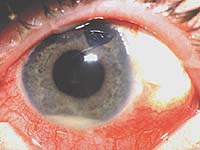 ---Interpalpebral mitomycin C bleb leading to endophthalmitis. Do not place blebs interpalpebral or inferior to the fornix. (Figure 4)
---Interpalpebral mitomycin C bleb leading to endophthalmitis. Do not place blebs interpalpebral or inferior to the fornix. (Figure 4)
Injected mitomycin C carries a high risk in primary surgery and is inappropriate for general use. One possible complication is vascular occlusion.
Intraoperative mitomycin C can cause long-term growth arrest at lower doses and extensive permanent cell death of local fibroblast population in the sclera and conjunctiva. Mitomycin C is really like a neutron bomb: it kills all the cells in the area, leaving the tissues acellular and avascular.
Concentrations now generally range from 0.1 mg/mL to 0.5 mg/mL, and the most common dose is around 0.2 mg/mL. Exposure times range from 30 seconds to 5 minutes, but based on the pharmacokinetic studies, it makes more sense to use a fixed time of about 3 minutes and to vary concentration.
Intraoperative mitomycin C is effective in patients with a persistent or aggressive healing response. However, mitomycin C requires the surgeon to reconstitute the drug from powder. It is more expensive and theoretically has a smaller safety margin. Complications include hypotony, cystic blebs with leaks (Figure 3), blebitis and endophthalmitis (Figure 4).
Minimize complications
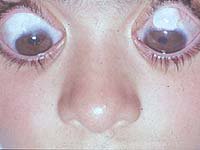 ---Left eye treated with mitomycin C 0.4 mg/mL (small treatment area), limbus-based flap and small scleral flap leading to focal cystic bleb. Right eye treated with mitomycin C 0.5 mg/mL (larger area), fornix-based flap and large scleral flap leading to diffuse non-cystic bleb. (Figure 5)
---Left eye treated with mitomycin C 0.4 mg/mL (small treatment area), limbus-based flap and small scleral flap leading to focal cystic bleb. Right eye treated with mitomycin C 0.5 mg/mL (larger area), fornix-based flap and large scleral flap leading to diffuse non-cystic bleb. (Figure 5)
It is important to maintain a consistent technique and to build up experience with these techniques. It is best to use gentler agents with minimal side effects and inconvenience (for example, intraoperative 5-FU) initially and move to stronger agents (intraoperative mitomycin C) with increasing experience. Subconjunctival injections of 5-FU can always be used to titrate the healing response postoperatively. The time of exposure is important, but laboratory experiments suggest that variation in drug concentration may be a more reproducible method of titration — usually 50 mg/mL with 5-FU and between 0.1 mg/mL to 0.4 mg/mL for mitomycin C in primary surgery. The vehicle of delivery should be consistent; hypotonic solutions (water) increase cellular drug uptake compared with isotonic solutions (normal saline). Different sponges of the same size deliver different doses to the tissues, therefore, it is best to use the same make of sponge.
Surgical details are important, as antimetabolites are very unforgiving. The area of antimetabolite treatment, the size of the scleral flap and the conjunctival area available are all extremely important. Small areas of treatment, scleral flaps or conjunctival areas (limbal incision close to sclerostomy) all result in focal, cystic avascular blebs, which are prone to leakage and endophthalmitis. A large treatment area, scleral flap and conjunctival area (posterior incision or fornix-based flap with no demarcation incision) result in a diffuse non-cystic bleb much less prone to infection and leakage even with mitomycin C 0.5 mg/mL (Figures 5 and 6). One of the reasons for a more diffuse bleb in so-called non-perforating surgery is the large scleral flap. The drainage area must not be in the interpalpebral area or in the inferior fornix, because then the risk of endophthalmitis may be up to 10 times higher.
Good scleral flap closure is essential, as this provides the only resistance in the early postoperative period. We never finish surgery until we are certain that there is adequate flap resistance. In high risk eyes (for example, buphthalmics, high myopes, Sturge-Weber), we use a continuous anterior chamber infusion and titrate the outflow.
Conclusion
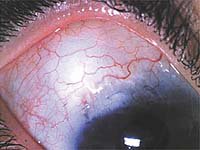 ---Diffuse non-cystic bleb following mitomycin C 0.5 mg/mL with large area of treatment and large scleral flap. (Figure 6)
---Diffuse non-cystic bleb following mitomycin C 0.5 mg/mL with large area of treatment and large scleral flap. (Figure 6)
Antimetabolites offer us the possibility of maximal IOP control, not just in high-risk patients, but in every patient undergoing filtration surgery. This may allow us to arrest the glaucomatous process in the majority of patients. However, these agents do carry long- and short-term risks. These risks may be minimized by assessing individual patients, using appropriate agents coupled with surgical techniques that maximize the short- and long-term efficacy and safety after surgery. Ultimately, the long-term surgical trials currently in progress will help us to decide if intraoperative anti metabolites are appropriate for every patient undergoing filtration surgery, and if this alters the long-term prognosis in glaucoma.
For Your Information:
- Peng T. Khaw, PhD, FRCP, FRCS, FRCOphth, is professor of wound healing and glaucoma studies and director of the pediatric/young adult glaucoma clinic and the Wound Healing Research Unit, Department of Pathology and Glaucoma, Moorfields Eye Hospital and Institute of Ophthalmology, 11-43 Bath St., London EC1V 9EL England; phone and fax: (44) 171-608-6887; e-mail: p.khaw@ucl.ac.uk. Dr. Khaw has no direct financial interest in any of the products mentioned in this article, nor is he a paid consultant for any companies mentioned.
